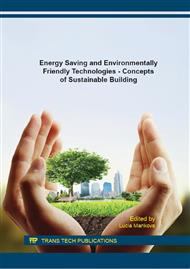p.339
p.347
p.355
p.363
p.371
p.379
p.387
p.395
p.403
Analysis of Thermal Performance of Energy Storage System
Abstract:
Thermal energy is necessary of many reasons. The most basic and most obvious includes food preparation and delivery of heat. Thermal energy storage is actually a temporary storage at high temperatures, respectively at low temperatures. It is an advanced technology, which can reduce environmental impact and it can facilitate more efficient and cleaner energy system. Nowadays, these systems have ability to retain thermal energy for a period of three months or more. The aim of design of these systems is to keep the thermal energy in summer period and to use it for heating in winter period. The role of such storage systems is to accumulate the heat, to balance temperature differences and to achieve the most effective use of the collected energy. This paper is focused on thermal analysis of system, which contains concrete tank. It is a system with water as a storage medium and the cooling of the water was monitored for 30 days.
Info:
Periodical:
Pages:
371-378
Citation:
Online since:
January 2016
Authors:
Price:
Сopyright:
© 2016 Trans Tech Publications Ltd. All Rights Reserved
Share:
Citation:


